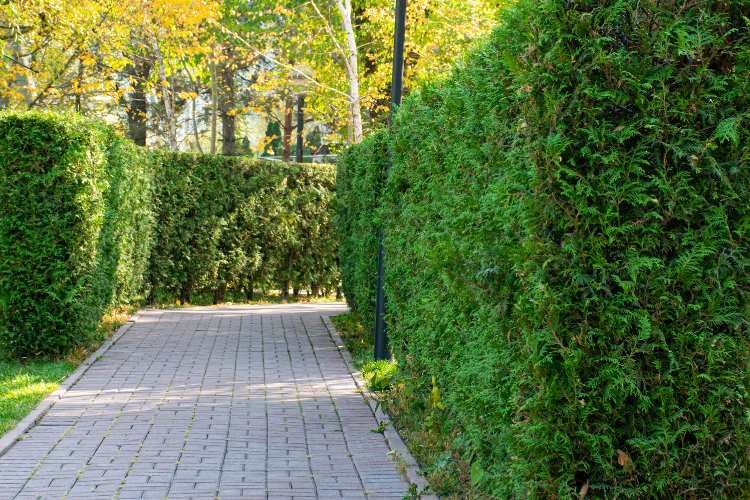Conifer Trees for Hedging: The Pros and Cons
16th Jul 2023
We definitely have a love hate relationship with conifer trees. Some love them for the way they grow so quickly. Others hate them for the same reason. There have been many neighbours falling out over a giant conifer hedge.
But what can’t be argued is that conifer trees are perfect if you want new hedge and you want it fast. Gardeners, landscapers, and developers alike turn to conifers when they need a hedge in a hurry. But there is far more to these trees than just their speed of growth.
Why conifer trees are ideal for hedging
A conifer hedge will provide privacy, delineate boundaries, act as a windbreak, and even create a home for wildlife. On top of that, as they are mostly evergreen, they provide an attractive all year-round screen. They also add visual interest to the garden with their different shades of green, blue, and even golden yellow. And, of course, most conifer trees will grow very quickly and only need the minimum of maintenance once they are established.
There are pros and cons to everything
I’ll hold my hand up here. I’m a devoted fan of using conifer trees for hedging and will always champion their cause. But, I admit, there are drawbacks to them too. So, in the interests of balance and fair play lets take a look at the pros and cons of using conifer trees for hedging. Let’s start with the positives.
10 benefits to using conifer trees for hedging
1 - Evergreen: Most conifers will remain green all year round. This adds colour and life to your garden, even during the long, dull, and dreary winter months.
2 - Privacy: Conifer hedges will grow tall and thick. Very quickly they create a natural privacy screen which will effectively screen your garden from view. What shouldn’t be overlooked is that this thick hedging barrier will also provide a security screen for your property. By the way, when planting your conifers be sure to space them out with around 60-100cm between each tree for maximum spread.
3 - Windbreak: Their dense growth will reduce wind speed and make a shelter for the more delicate plants in your garden. Conifer hedging can also shelter your polytunnel by protecting it from gusty winds.
4 - Noise reduction: It may be surprising but conifer tree hedging can absorb and deflect noise. If your garden borders a busy road, your hedge will reduce the amount of noise which makes it through to the other parts of your garden.
5 – A haven for wildlife: Over time your hedge will provide food and a mini habitat for a variety of local wildlife, including birds and insects.
6 - Low maintenance: Anyone, and I do mean anyone, can grow a conifer hedge. It’s more or less plant, water, and forget. Once established, your hedge won’t need any looking after apart from cutting back to keep their growth under control.
7 – Variety of choice: Conifers aren’t just green and boring. There is a surprising number of species all with their own look and characteristics. You can choose from different sizes, shapes, and colours to make your garden pop.
8 – Can help prevent soil erosion: The root systems of conifer trees help to prevent soil erosion, particularly on slopes or embankments.
9 - Longevity: Conifers are typically long-lived, they are definitely not a plant today, gone tomorrow species. Their long life will ensure that your hedge will be an attractive feature of your garden for many years.
10 – Eco friendly: We all like to tick this box. Conifers absorb carbon dioxide which will help reduce the overall carbon footprint of your garden. Which can’t be a bad thing.
The Cons of Using Conifers for Hedging
As much as I am a fan of conifers, I do admit they also have some drawbacks. The main strike against them is that some varieties can grow massive if not properly maintained. Additionally, diseases such as conifer dieback and pests like aphids can pose a threat.
10 disadvantages to using conifer trees for hedging
1 - Overgrowth: Even though they are very low maintenance conifers do need pruning or cutting back regularly. They can grow very big very quickly, and they will rapidly get out of control if not regularly pruned. This can lead to neighbourly disputes or just a massive headache when you finally do decide to cut them back.
2 – Not all UK hardy: Some of the more exotic non-native varieties of conifer can have limited tolerance to different soil types, pH levels, or the UK climate, which can affect their survival and growth.
3 - Pests and diseases: Like all plants and trees conifers can be susceptible to pests and diseases. Aphids or conifer dieback can damage or kill the trees if not treated.
4 - Slow growing: Most common conifers are fast-growing but pick the ‘wrong’ variety and you won’t have a tall hedge for a long time. Some species, like the yew, are slow-growing, which means it may take several years for the hedge to become fully established.
5 – Tricky pruning: Take care when cutting back your hedge. Many conifers will not regrow from old wood. This means that if you don’t take care your pruning could leave bare patches which won't recover. This will affect the appearance of your hedge as well as creating gaps.
6 - Watering: Once established conifers are generally drought-resistant. However, young plants will require regular watering. This is something to be aware of when you first plant your hedge, particularly during dry spells or if hose pipe bans are in pace.
7 - Non-native species: A couple of decades ago there was a huge controversy in the UK over the mass planting of non-native conifers. On a smaller scale planting non-native species in your garden could have an impact on your local ecosystem.
8 - Litter: Conifer hedging is like a magnet for rubbish. Any dropped litter will be blown into the hedge which is an absolute pain. Be prepared to regularly litter pick if your garden is in an urban environment.
9 - Root damage: Very much a long-term issue but larger conifers have extensive root systems. This can potentially cause damage to nearby pavements or structures.
10 – Blocks light: Tall and dense conifer hedges can significantly reduce light to gardens or windows if not carefully positioned and maintained.
I think you’ll agree the pros to using conifer trees for hedging comfortably outweighs the cons. If you’re thinking of planting a new hedge you can see all the conifers, we currently have in the nursery in the hedging section of the website.


